Bullfrog Care (Rana catesbeiana)
Erica Mede, CVT
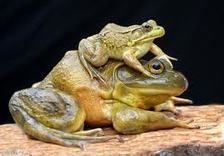
American bullfrogs are part of the family Ranidae (the “true frogs”) and are frequently kept as pets. Many times people will catch small frogs or tadpoles and raise them to adults. Keeping wild caught amphibians is never recommend due to the stress of captivity, parasite infestations, and other diseases that can be spread to humans and/or other pets. People interested in these pets can find them easily at most pet stores and there are many breeders who breed for specific colorations such as albino.
Reptile rescues and nature centers are constantly asked to accept relinquished Bullfrogs and most no longer accept these animals. Because of the large volume of amphibians requiring homes and inadequate room at rescues, many people release these animals back into the wild. Never release a captive amphibian! Bullfrogs in most areas are invasive and can have serious detrimental effects on the ecosystem. Introduced populations compete for food with native species and their populations can spiral out of control. Please, if you are considering this kind of pet consider adopting one from a herpetile rescue.
Natural History
The original distribution of the American bullfrog was along the eastern seaboard from Florida to New England . The species was introduced into the west 19th and 20th century for cooking purposes and are now common in many streams, rivers, ponds, lakes, and wet lands across the nation. The tell tale bellowing call of the male at night can be heard in late summer into early fall.
Reptile rescues and nature centers are constantly asked to accept relinquished Bullfrogs and most no longer accept these animals. Because of the large volume of amphibians requiring homes and inadequate room at rescues, many people release these animals back into the wild. Never release a captive amphibian! Bullfrogs in most areas are invasive and can have serious detrimental effects on the ecosystem. Introduced populations compete for food with native species and their populations can spiral out of control. Please, if you are considering this kind of pet consider adopting one from a herpetile rescue.
Natural History
The original distribution of the American bullfrog was along the eastern seaboard from Florida to New England . The species was introduced into the west 19th and 20th century for cooking purposes and are now common in many streams, rivers, ponds, lakes, and wet lands across the nation. The tell tale bellowing call of the male at night can be heard in late summer into early fall.
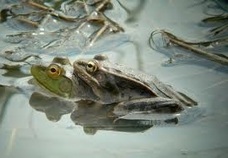
Description
This is North America ’s largest species with a broad flat head and a total length reaching up to 8 inches. These frogs have green backs with netlike patterns of brown or gray. The underside is white with gray mottling and a yellow color on the chin and hind legs. The back legs are powerful and long; made for jumping large distances between 3 and 6 feet! Most bullfrogs will live 3-5 years.
Sexing
Males are easily identified by their yellow throat and large tympanum (ear drum). The tympanum of the male is twice as large as its eyes. During breeding season the nuptial pads are seen on the front limbs as an engorgement of tissue.
This is North America ’s largest species with a broad flat head and a total length reaching up to 8 inches. These frogs have green backs with netlike patterns of brown or gray. The underside is white with gray mottling and a yellow color on the chin and hind legs. The back legs are powerful and long; made for jumping large distances between 3 and 6 feet! Most bullfrogs will live 3-5 years.
Sexing
Males are easily identified by their yellow throat and large tympanum (ear drum). The tympanum of the male is twice as large as its eyes. During breeding season the nuptial pads are seen on the front limbs as an engorgement of tissue.
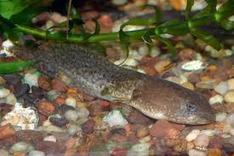
Enclosures
This species requires lots of space, especially wild caught individuals, as they tend to jump repeatedly into glass. Visual barricades such as newspaper or decorative back drops for aquariums can be used to reduce stress and rostral abrasions (skinned noses). The minimum cage provided for this species should be a 20 gallon aquarium with an additional 5 gallons per additional animal. This ensures there is plenty of room and hiding spots to prevent territorial aggression and subsequent cannibalism.
A semi-aquatic environment works best. The aquatic portion should occupy a large portion of the cage and be permanently partitioned off by sealing a piece of Plexiglass with aquarium grade silicone. Tap or spring water can be treated with a dechlorinator or left to sit uncovered for 24 hours. Never use distilled water as this will cause bloat and eventual death due to lack of minerals. Feces and uneaten food will need to be removed daily from the water. An appropriate size filter is invaluable for the aquatic portion of the enclosure but may aggravate wild caught bullfrogs. If a filter isn’t used, a 50% water change should be performed twice a week and a full cleaning once every 3-4 weeks. Aquatic vegetation such as Salvinia auriculata will help to maintain water quality.
Hide areas in the water and on land are essential to minimizing stress and allowing this high strung species to relax. A basking log or rock should be made available. Driftwood is a great transition from water to land and makes for an excellent basking spot.
Air temperatures in the cage should range between 77 and 84 degrees Fahrenheit. Fluorescent lights or ceramic heat emitters should be used for basking spots. Under tank heaters can be used for substrate and water. If the aquatic portion is too large or deep, a submersible heater can be used but isn’t generally needed. The water temperature should be maintained in the mid 70’s. Two thermometers are recommended; one for the warm basking spot and one for the water. It is also recommended that the enclosure has a 5.0 UVB bulb.
This species requires lots of space, especially wild caught individuals, as they tend to jump repeatedly into glass. Visual barricades such as newspaper or decorative back drops for aquariums can be used to reduce stress and rostral abrasions (skinned noses). The minimum cage provided for this species should be a 20 gallon aquarium with an additional 5 gallons per additional animal. This ensures there is plenty of room and hiding spots to prevent territorial aggression and subsequent cannibalism.
A semi-aquatic environment works best. The aquatic portion should occupy a large portion of the cage and be permanently partitioned off by sealing a piece of Plexiglass with aquarium grade silicone. Tap or spring water can be treated with a dechlorinator or left to sit uncovered for 24 hours. Never use distilled water as this will cause bloat and eventual death due to lack of minerals. Feces and uneaten food will need to be removed daily from the water. An appropriate size filter is invaluable for the aquatic portion of the enclosure but may aggravate wild caught bullfrogs. If a filter isn’t used, a 50% water change should be performed twice a week and a full cleaning once every 3-4 weeks. Aquatic vegetation such as Salvinia auriculata will help to maintain water quality.
Hide areas in the water and on land are essential to minimizing stress and allowing this high strung species to relax. A basking log or rock should be made available. Driftwood is a great transition from water to land and makes for an excellent basking spot.
Air temperatures in the cage should range between 77 and 84 degrees Fahrenheit. Fluorescent lights or ceramic heat emitters should be used for basking spots. Under tank heaters can be used for substrate and water. If the aquatic portion is too large or deep, a submersible heater can be used but isn’t generally needed. The water temperature should be maintained in the mid 70’s. Two thermometers are recommended; one for the warm basking spot and one for the water. It is also recommended that the enclosure has a 5.0 UVB bulb.
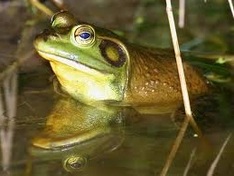
Handling
Handling should be kept to a bare minimum. When catching the animal from the cage you can use a soft net. Make sure to always have control of the back legs! Gently grasping behind the head and the front legs with one hand and around the rear legs with the second hand is an appropriate method of restraint and safe handling.
Feeding
Adults have a strong sense of sight and will eat anything that fits in their mouth. Captive adults are frequently fed earth worms, crickets, meal worms, goldfish (this should be limited), crayfish, and mice (feed sparingly). Bullfrogs are prone to obesity. Large adults should only be fed 2-3 times a week in moderation. Younger frogs can be fed size appropriate food every other day.
It is not recommended to feed bullfrogs from your hand as they can have a painful bite. Placing the food in a dish or on a rock is a better option. eeding with forceps is a very popular method as well. Calcium supplementation without phosphorous can be added to the food weekly and a multivitamin supplement every 2 weeks.
Handling should be kept to a bare minimum. When catching the animal from the cage you can use a soft net. Make sure to always have control of the back legs! Gently grasping behind the head and the front legs with one hand and around the rear legs with the second hand is an appropriate method of restraint and safe handling.
Feeding
Adults have a strong sense of sight and will eat anything that fits in their mouth. Captive adults are frequently fed earth worms, crickets, meal worms, goldfish (this should be limited), crayfish, and mice (feed sparingly). Bullfrogs are prone to obesity. Large adults should only be fed 2-3 times a week in moderation. Younger frogs can be fed size appropriate food every other day.
It is not recommended to feed bullfrogs from your hand as they can have a painful bite. Placing the food in a dish or on a rock is a better option. eeding with forceps is a very popular method as well. Calcium supplementation without phosphorous can be added to the food weekly and a multivitamin supplement every 2 weeks.
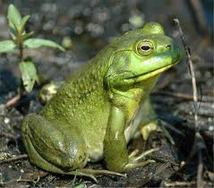
Common Medical Problems
Good husbandry is the best way to prevent many problems. Bullfrogs should be quarantined for at least three to six months before being added to an established collection.
Red Leg is a generic term for a condition that can be caused by bacterial infection, fungal infections, or environmental issues. This condition will cause an increase to the blood circulation in the limbs. This causes redness on the bottom of the arms and legs often leading to open sores. If these symptoms are seen, please make an appointment with Chicago Exotics.
Vomiting/Regurgitating are common signs of gastrointestinal obstruction. If these are noted, an appointment with Chicago Exotics’ should be made immediately, especially if accompanied by swelling or loss of appetite.
Internal parasites are diagnosed by a fecal test by a Chicago Exotics’ veterinary professional. A fecal test for internal parasites is recommended at least yearly.
Other common signs of problems include loss of appetite, loose stools, difficulty shedding, and lumps/bumps. Please make an appointment with your veterinarian to diagnose and treat any of these problems.
Speak with your Chicago Exotics’ veterinarian or technician about Salmonella and what measures are recommended to limit the risk or transmission to people.
Sources and Suggested Reading
If you have any questions, please feel free to call us at 847-329-8709.
Good husbandry is the best way to prevent many problems. Bullfrogs should be quarantined for at least three to six months before being added to an established collection.
Red Leg is a generic term for a condition that can be caused by bacterial infection, fungal infections, or environmental issues. This condition will cause an increase to the blood circulation in the limbs. This causes redness on the bottom of the arms and legs often leading to open sores. If these symptoms are seen, please make an appointment with Chicago Exotics.
Vomiting/Regurgitating are common signs of gastrointestinal obstruction. If these are noted, an appointment with Chicago Exotics’ should be made immediately, especially if accompanied by swelling or loss of appetite.
Internal parasites are diagnosed by a fecal test by a Chicago Exotics’ veterinary professional. A fecal test for internal parasites is recommended at least yearly.
Other common signs of problems include loss of appetite, loose stools, difficulty shedding, and lumps/bumps. Please make an appointment with your veterinarian to diagnose and treat any of these problems.
Speak with your Chicago Exotics’ veterinarian or technician about Salmonella and what measures are recommended to limit the risk or transmission to people.
Sources and Suggested Reading
- Reptiles Magazine
- Exotic DVM Magazine
- Amphibians and Reptiles of the Great Lakes Region, James H. Harding
- Amphibian Medicine and Captive Husbandry, Wright and Whitaker
If you have any questions, please feel free to call us at 847-329-8709.
